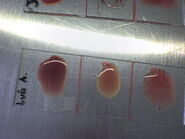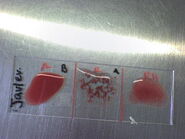Assessment |
Biopsychology |
Comparative |
Cognitive |
Developmental |
Language |
Individual differences |
Personality |
Philosophy |
Social |
Methods |
Statistics |
Clinical |
Educational |
Industrial |
Professional items |
World psychology |
Biological: Behavioural genetics · Evolutionary psychology · Neuroanatomy · Neurochemistry · Neuroendocrinology · Neuroscience · Psychoneuroimmunology · Physiological Psychology · Psychopharmacology (Index, Outline)
- Main article: Psychological aspects of blood
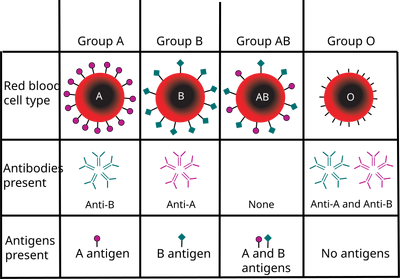
ABO blood group antigens present on red blood cells and IgM antibodies present in the serum
The ABO blood group system is the most important blood type system (or blood group system) in human blood transfusion. The associated anti-A antibodies and anti-B antibodies are usually IgM antibodies, which are usually produced in the first years of life by sensitization to environmental substances such as food, bacteria and viruses. ABO blood types are also present in some animals, for example apes such as humans, chimpanzees, gorillas and orangutans.
ABO antigens[]
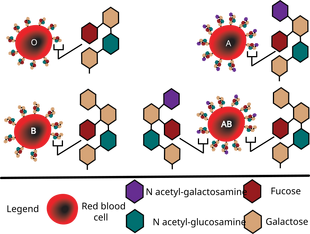
Diagram showing the carbohydrate chains which determine the ABO blood group
The A antigen and the B antigen are derived from a common precursor known as the H antigen (or H substance). The H antigen is a glycosphingolipid (sphingolipid with carbohydrates linked to the ceramide moiety). Since it lacks N-acetylneuraminic acid (sialic acid) it is referred to as a globoside, not a ganglioside. In blood group O the H antigen remains unchanged and consists of a chain of galactose, N-Acetylglucosamine, galactose, and fructose attached to the ceramide. H antigens can be changed into A or B antigens by enzymes coded by the blood group A or B genes. Type A has an extra N-Acetylgalactosamine bonded to the galactose near the end, while type B has an extra galactose bonded to the galactose near the end.
Individuals with Type A blood can accept blood from donors of type A and type O blood. Individuals with type B blood can receive blood from donors of type B and type O blood. Individuals with type AB blood may receive blood from donors of type A, type B, type AB, or type O blood. Type AB blood is referred to the universal recipient. Individuals of type O blood may receive blood from donors of type O blood. Type O blood is called the universal donor.
Antibodies are not formed against the H antigen, except by those with the Bombay phenotype.
In ABH secretors, ABH antigens are secreted by most mucous-producing cells of the body interfacing with the environment, including lung, skin, liver, pancreas, stomach, intestines, ovaries and prostate.
History of discovery[]
The ABO blood group system is widely credited to have been discovered by the Austrian scientist Karl Landsteiner, who found three different blood types in 1901;[1] he was awarded the Nobel Prize in Physiology or Medicine in 1930 for his work. Due to inadequate communication at the time it was subsequently found that Czech serologist Jan Janský had independently pioneered the classification of human blood into four groups,[2] but Landsteiner's independent discovery had been accepted by virtually the whole scientific world while Janský remained in relative obscurity. Janský's classification is however still used in Russia and states of former USSR (see below). In America Moss published his own (very similar) work in 1910.[3] Landsteiner described A, B, and O; Decastrello and Sturli discovered the fourth type, AB, in 1907.[4]
Serology[]
Anti-A and anti-B antibodies, which are not present in the newborn, appear in the first years of life. It is thought that food and environmental antigens (bacterial, viral or plant antigens) are similar enough to A and B glycoprotein antigens that antibodies created against the environmental antigens in the first years of life can cross react with ABO-incompatible red blood cells. Anti-A and anti-B antibodies are usually IgM, which are not able to pass through the placenta to the fetal blood circulation.
ABO hemolytic disease of the newborn[]
- Main article: ABO hemolytic disease of the newborn
ABO blood group incompatibilities between the mother and child does not usually cause hemolytic disease of the newborn (HDN) because antibodies to the ABO blood groups are usually of the IgM type, which do not cross the placenta; however, sometimes IgG ABO antibodies are produced and a baby can develop ABO HDN.
Population data[]
The distribution of the blood groups A, B, O and AB varies across the world according to the population or race. There are also variations in blood type distribution within human subpopulations.
In the UK the distribution of blood type frequencies through the population still shows some correlation to the distribution of placenames and to the successive invasions and migrations including Vikings, Danes, Saxons, Celts, and Normans who contributed the phonemes to the placenames and the genes to the population. [5]
Distribution of blood types among various populations[6]
| Population | O | A | B | AB |
|---|---|---|---|---|
| Native South Americans | 100% | – | – | – |
| British | 46% | 42% | 9% | 3% |
| Irish | 52% | 35% | 10% | 3% |
| French | 43% | 45% | 9% | 3% |
| Hongkonger | 40% | 26% | 27% | 7% |
| Vietnamese | 45.0% | 21.4% | 29.1% | 4.5% |
| Australian aboriginals | 44.4% | 55.6% | – | – |
| Germans | 42.8% | 41.9% | 11.0% | 4.2% |
| Bengalis | 22.0% | 24.0% | 38.2% | 15.7% |
| Saami | 18.2% | 54.6% | 4.8% | 12.4% |
| Finns | 31% | 44% | 17% | 8% |
Inheritance[]
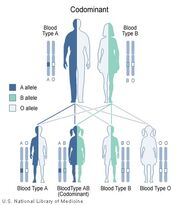
A and B are codominant, giving the AB phenotype.
Blood groups are inherited from both parents. The ABO blood type is controlled by a single gene with three alleles: i, IA, and IB. The gene encodes a glycosyltransferase - that is, an enzyme that modifies the carbohydrate content of the red blood cell antigens. The gene is located on the long arm of the ninth chromosome (9q34).
IA allele gives type A, IB gives type B, and i gives type O. IA and IB are dominant over i, so ii people have type O, IAIA or IAi have A, and IBIB or IBi have type B. IAIB people have both phenotypes because A and B express a special dominance relationship: codominance, which means that type A and B parents can have an AB child. Thus, it is extremely unlikely for a type AB parent to have a type O child (it is not, however, direct proof of illegitimacy): the cis-AB phenotype has a single enzyme that creates both A and B antigens. The resulting red blood cells do not usually express A or B antigen at the same level that would be expected on common group A1 or B red blood cells, which can help solve the problem of an apparently genetically impossible blood group. [8]
Evolutionary biologists theorize that the IA allele evolved earliest, followed by O (by the deletion of a single nucleotide, shifting the reading frame) and then IB.[citation needed] This chronology accounts for the percentage of people worldwide with each blood type. It is consistent with the accepted patterns of early population movements and varying prevalent blood types in different parts of the world: for instance, B is very common in populations of Asian descent, but rare in ones of Western European descent.)
| Mother/Father | O | A | B | AB |
|---|---|---|---|---|
| O | O | O, A | O, B | A, B |
| A | O, A | O, A | O, A, B, AB | A, B, AB |
| B | O, B | O, A, B, AB | O, B | A, B, AB |
| AB | A, B | A, B, AB | A, B, AB | A, B, AB |
Bombay phenotype[]
- Main article: Hh antigen system
Individuals with the rare Bombay phenotype (hh) do not express substance H on their red blood cells, and therefore do not bind A or B antigens. Instead, they produce antibodies to substance H (which is present on all red cells except those of hh genotype) as well as to both A and B antigens, and are therefore compatible only with other hh donors.
Nomenclature in Europe former USSR[]
In parts of Europe the "O" in ABO blood type is substituted with "0" (zero), signifying the lack of A or B antigen. In the former USSR and Russia, blood types are referenced using numbers and Roman numerals instead of letters. This is Janský's original classification of blood types. It designates the blood types of humans as I, II, III, and IV, which are elsewhere designated, respectively, as O, A, B, and AB. [9]
Examples of ABO and Rhesus D slide testing method[]
In the slide testing method shown above, three drops of blood are placed on a glass slide with liquid reagents. Agglutination indicates the presence of blood group antigens in the blood.
See also[]
References[]
- ↑ Landsteiner K. Zur Kenntnis der antifermentativen, lytischen und agglutinierenden Wirkungen des Blutserums und der Lymphe. Zentralblatt Bakteriologie 1900;27:357-62.
- ↑ Jansky J, 'Haematologick studie u. psychotiku', Sborn. Klinick;, 1907, 8: 85-139.
- ↑ Moss W L, Studies on isoagglutinins and isohemolysins, Bull. Johns Hopk. Hosp., 1910, 21:63-70.
- ↑ von Decastello A, Sturli A, Ueber die Isoagglutinine im Serum gesunder und kranker Menschen, Mfinch. med. Wschr., 1902, 49: 1090-1095.
- ↑ Potts, WTW (1979). "History and Blood Groups in the British Isles" Sawyer PH English Medieval Settlement, St. Martin's Press. ISBN 0-7131-6257-0.
- ↑ Mourant, A. E.; Ada C. Kopeć, Kazimiera Domaniewska-Sobczak (1976). The distribution of the human blood groups, and other polymorphisms, London: Oxford University Press. ISBN 0-19-264167-0.
- ↑ (2005). HKRCBTS - Blood Statistics. Hong Kong Red Cross Blood Transfusion Service. URL accessed on 2006-10-25.
- ↑ Yazer MH, Olsson ML, Palcic MM. The cis-AB Blood Group Phenotype: Fundamental Lessons in Glycobiology. Transfus Med Rev, July 1, 2006; 20(3): 207-217.
- ↑ Erb IH, Blood Group Classifications, a Plea for Uniformity. Can Med Assoc J. 1940 May; 42(5): 418–421. Full text at PMC: 537907
Further reading[]
- Blood group serology--the first four decades (1900--1939). Medical History journal, 1979.
External links[]
Transfusion medicine | |
|---|---|
| General concepts |
Apheresis (Plasmapheresis, Plateletpheresis, Leukapheresis) - Blood transfusion - Coombs test - Cross-matching - Exchange transfusion - International Society of Blood Transfusion - Intraoperative blood salvage - ISBT 128 - Transfusion reactions |
| Human blood group systems - Blood type |
ABO - Chido-Rodgers - Colton - Cromer - Diego - Dombrock - Duffy - Gerbich - GIL - Hh - Ii - Indian - JMH - Kell (Xk) - Kidd - Knops - Landsteiner-Weiner - Lewis - Lutheran - MNS - OK - P - Raph - Rh - Scianna - T-Tn - Xg - Yt |
| Blood products |
Blood donation - Blood substitutes - Cryoprecipitate - Platelets - Plasma - Red blood cells |
| This page uses Creative Commons Licensed content from Wikipedia (view authors). |
